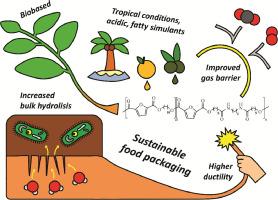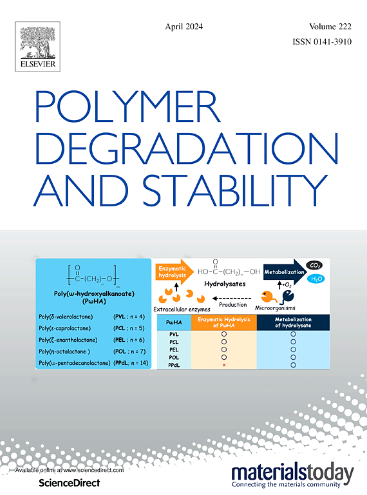Mechanical properties, gas permeability and biodegradation mechanism of biobased poly(ester amide)s from 2,5-furandicarboxylic acid and amido diols for sustainable food packaging
IF 6.3
2区 化学
Q1 POLYMER SCIENCE
引用次数: 0
Abstract
The aim of this work was to evaluate the functional properties of a family of poly(ester amide)s (PEAs) for flexible food packaging applications. The polymers under study were previously synthesized via random copolymerization of furan 2,5-dicarboxylic acid (2,5-FDCA) with different amounts of 1,10-decanediol and an amido diol (AD 46). Poly(decamethylene furanoate) (PDF) and poly(ester amide) 46 (PEA 46) were the reference homopolymers. PEA copolymers were compression molded into films and subjected to WAXS, DSC, SEM analyses and water contact angle, mechanical, gas barrier tests. The results showed a remarkable improvement in the functional properties of PEAs compared to those of PDF, with a decrease up to about 50% of O2 and CO2 transmission rates, which were found to be comparable to those of commercial PET. The mechanical properties of PEAs were also improved in comparison with PDF because of the increased toughness and higher resistance to plastic deformation, paired with elongation at break up to 650%. In order to assess the effects of contact with food, the prepared films were treated with food simulants. Moreover, the films were stored in conditions of controlled temperature and humidity, chosen to replicate real scenarios of application involving aggressive environmental conditions. After contact with food simulant liquids, the materials became more rigid and less ductile, but their gas barrier properties remained superior to those of commercially widespread polyolefins. Finally, films were subjected to composting tests: the higher the amido diol content, the faster the degradation rate, which occurred via a mechanism of bulk hydrolysis, because of the higher hydrophilicity of amide groups. Overall, the results highlighted the potential of PEA copolymers for the production of biobased, sustainable, flexible food packaging.

用于可持续食品包装的 2,5-呋喃二羧酸和氨基二醇生物基聚(酯酰胺)的机械性能、气体渗透性和生物降解机理
这项研究的目的是评估用于食品软包装的一系列聚(酯酰胺)(PEAs)的功能特性。所研究的聚合物是以前通过 2,5-呋喃二甲酸(2,5-FDCA)与不同量的 1,10-癸二醇和氨基二醇(AD 46)无规共聚合合成的。聚(呋喃十甲酸)(PDF)和聚(酯酰胺)46 (PEA 46) 是参照均聚物。PEA 共聚物被压缩成型为薄膜,并进行了 WAXS、DSC、SEM 分析以及水接触角、机械和气体阻隔性测试。结果表明,与 PDF 相比,PEA 的功能特性有了明显改善,氧气和二氧化碳透过率降低了约 50%,与商用 PET 不相上下。与 PDF 相比,PEA 的机械性能也有所改善,因为其韧性增强,抗塑性变形能力提高,断裂伸长率高达 650%。为了评估与食品接触的影响,用食品模拟物对制备的薄膜进行了处理。此外,还将薄膜储存在温度和湿度受控的条件下,以复制涉及侵蚀性环境条件的实际应用场景。与食品模拟液体接触后,材料变得更加坚硬,延展性降低,但其气体阻隔性能仍然优于市场上广泛使用的聚烯烃。最后,对薄膜进行了堆肥试验:酰胺二醇含量越高,降解速度越快,由于酰胺基团的亲水性较强,降解是通过大量水解的机制进行的。总之,研究结果凸显了 PEA 共聚物在生产生物基、可持续、柔性食品包装方面的潜力。
本文章由计算机程序翻译,如有差异,请以英文原文为准。
求助全文
约1分钟内获得全文
求助全文
来源期刊

Polymer Degradation and Stability
化学-高分子科学
CiteScore
10.10
自引率
10.20%
发文量
325
审稿时长
23 days
期刊介绍:
Polymer Degradation and Stability deals with the degradation reactions and their control which are a major preoccupation of practitioners of the many and diverse aspects of modern polymer technology.
Deteriorative reactions occur during processing, when polymers are subjected to heat, oxygen and mechanical stress, and during the useful life of the materials when oxygen and sunlight are the most important degradative agencies. In more specialised applications, degradation may be induced by high energy radiation, ozone, atmospheric pollutants, mechanical stress, biological action, hydrolysis and many other influences. The mechanisms of these reactions and stabilisation processes must be understood if the technology and application of polymers are to continue to advance. The reporting of investigations of this kind is therefore a major function of this journal.
However there are also new developments in polymer technology in which degradation processes find positive applications. For example, photodegradable plastics are now available, the recycling of polymeric products will become increasingly important, degradation and combustion studies are involved in the definition of the fire hazards which are associated with polymeric materials and the microelectronics industry is vitally dependent upon polymer degradation in the manufacture of its circuitry. Polymer properties may also be improved by processes like curing and grafting, the chemistry of which can be closely related to that which causes physical deterioration in other circumstances.
 求助内容:
求助内容: 应助结果提醒方式:
应助结果提醒方式:


